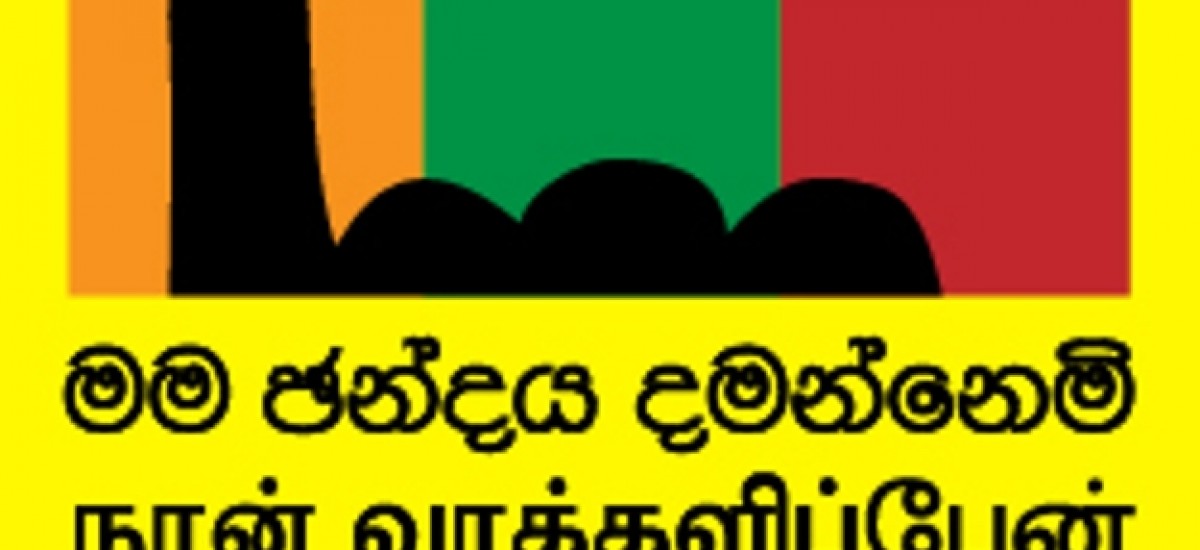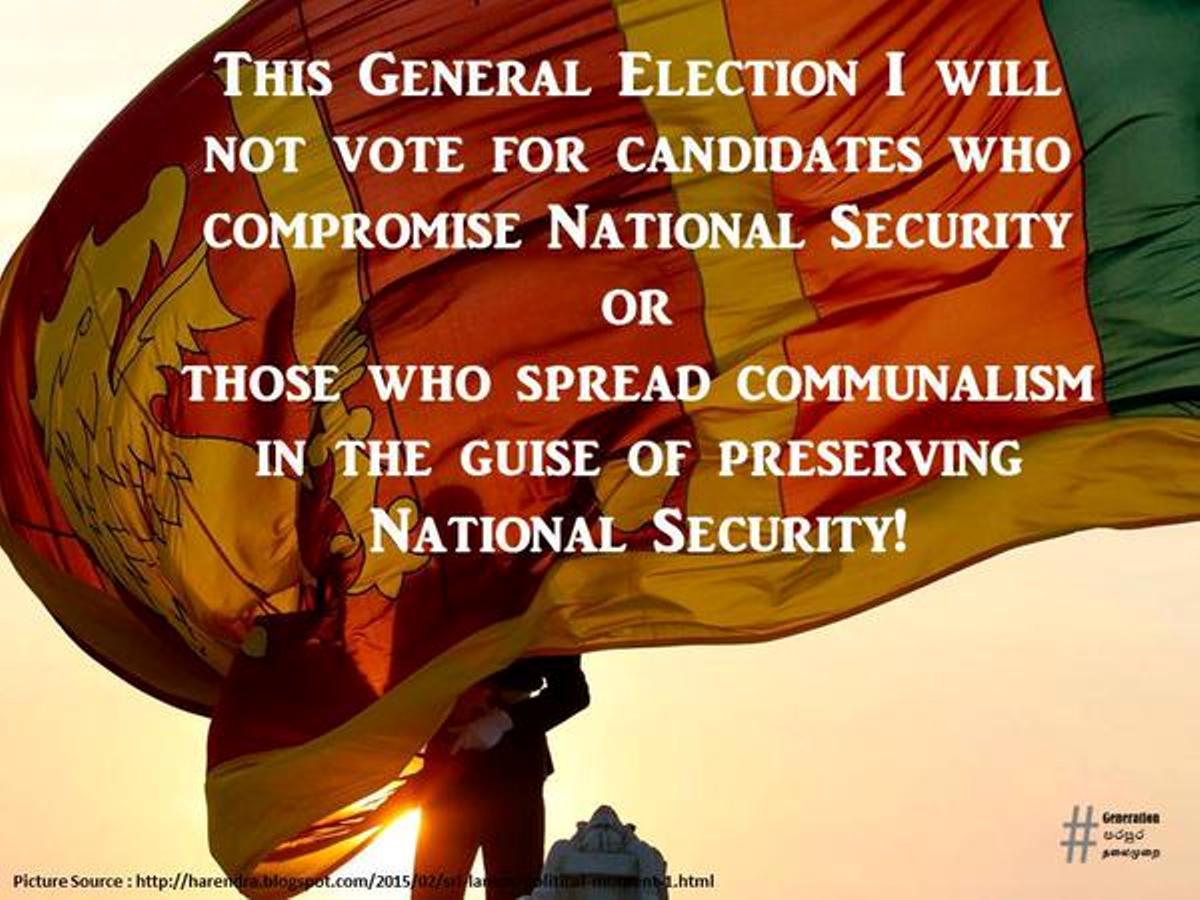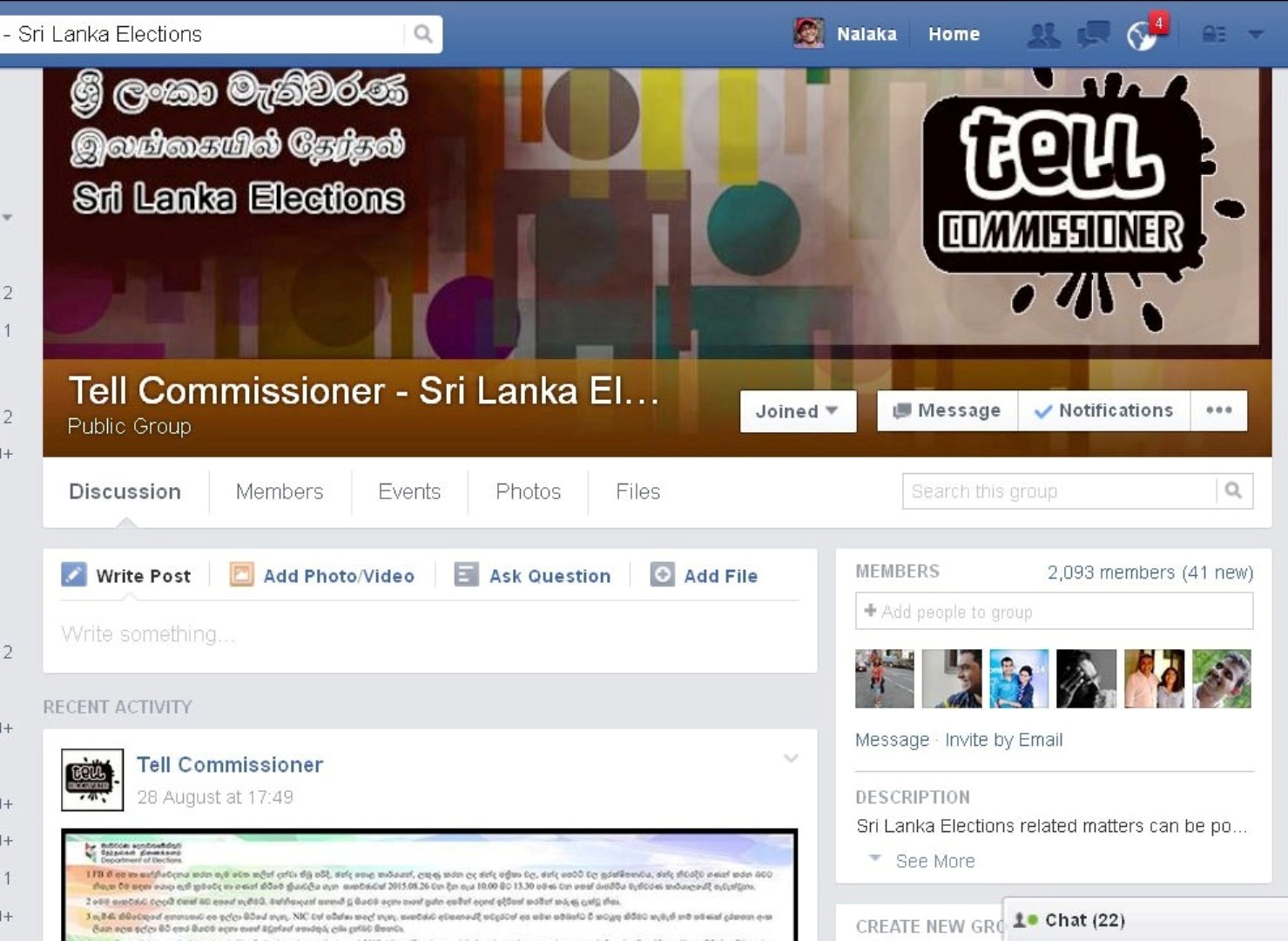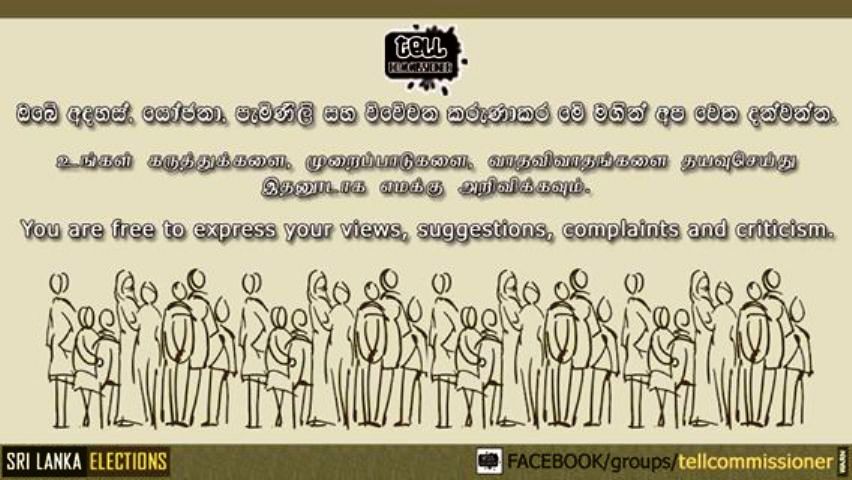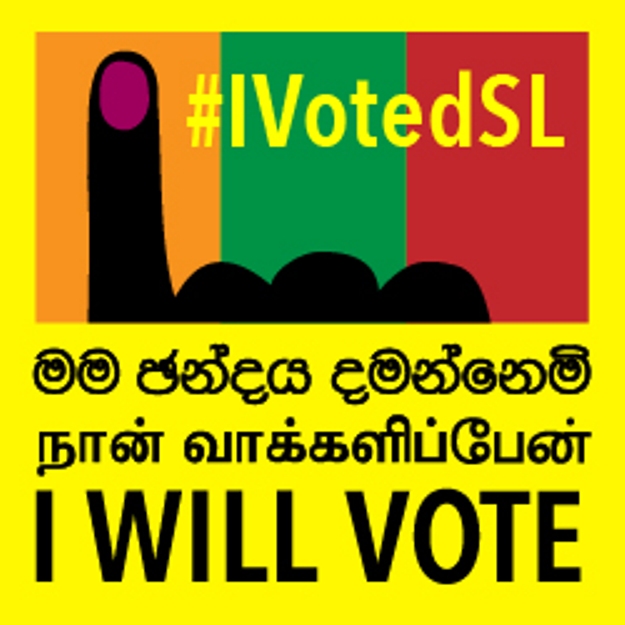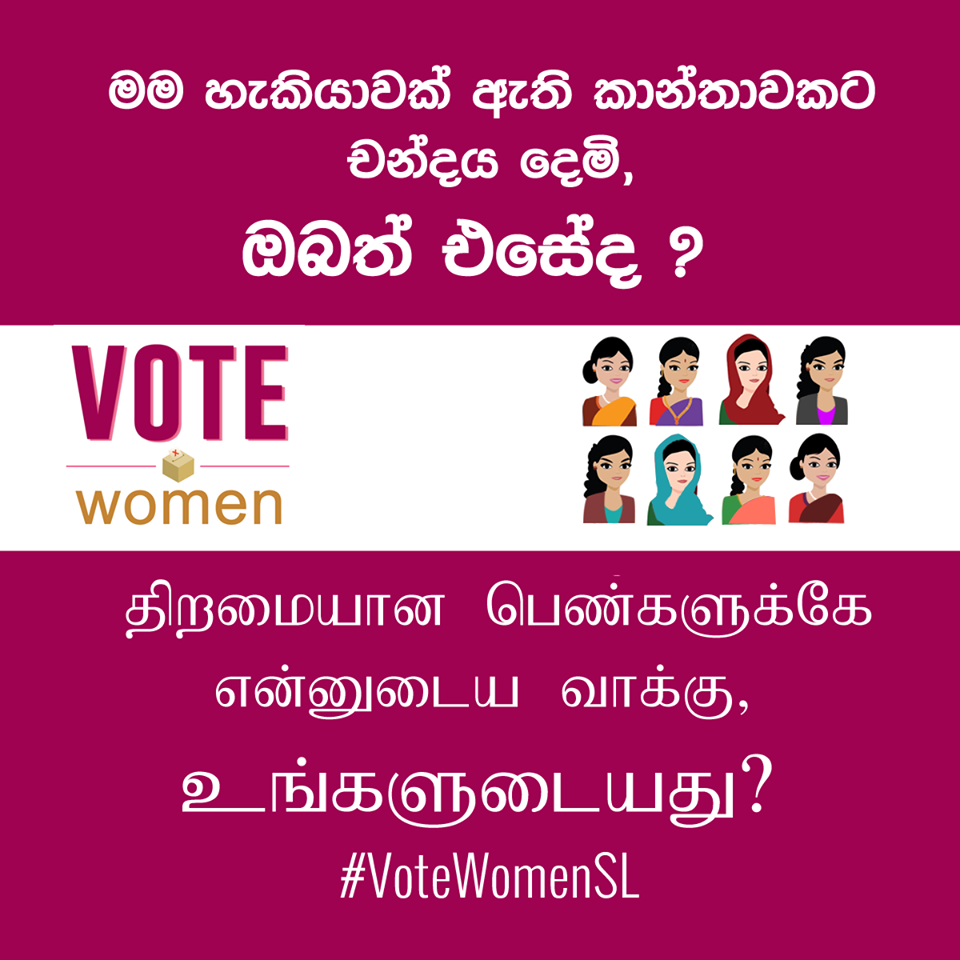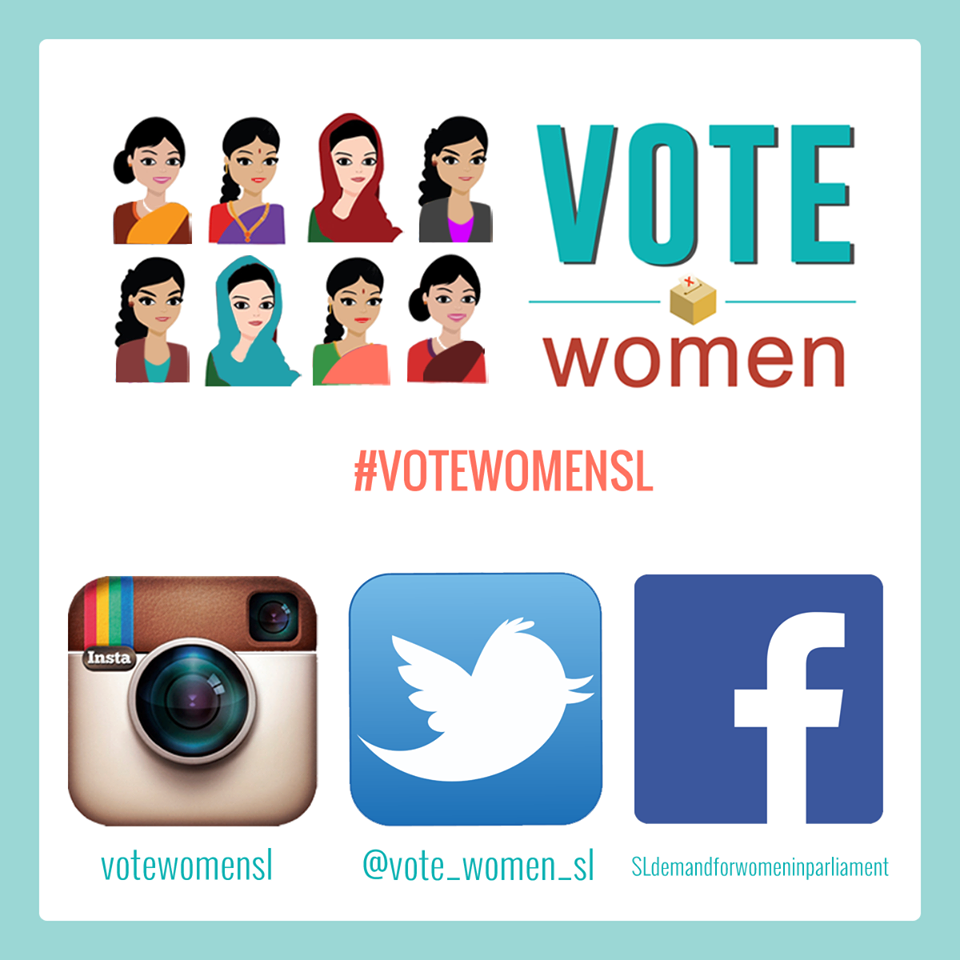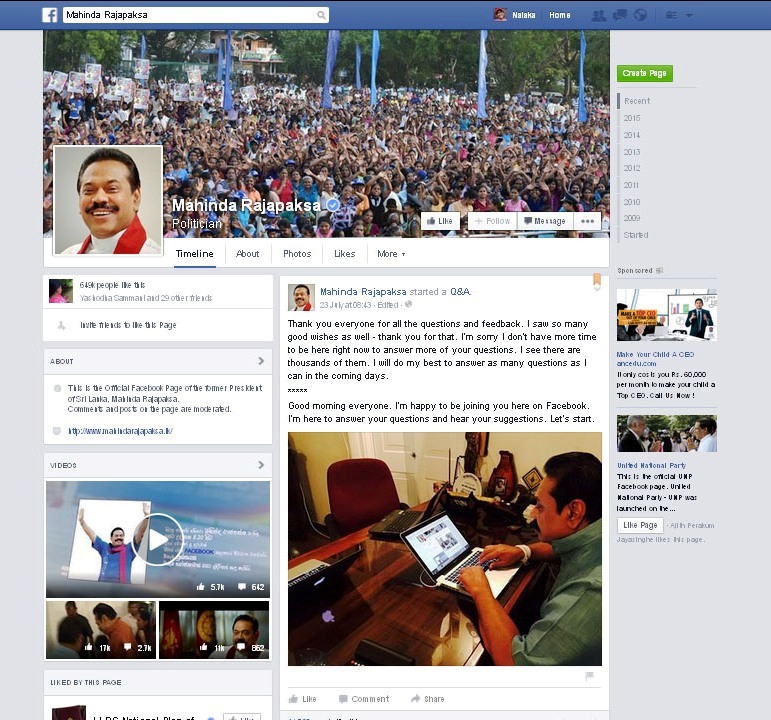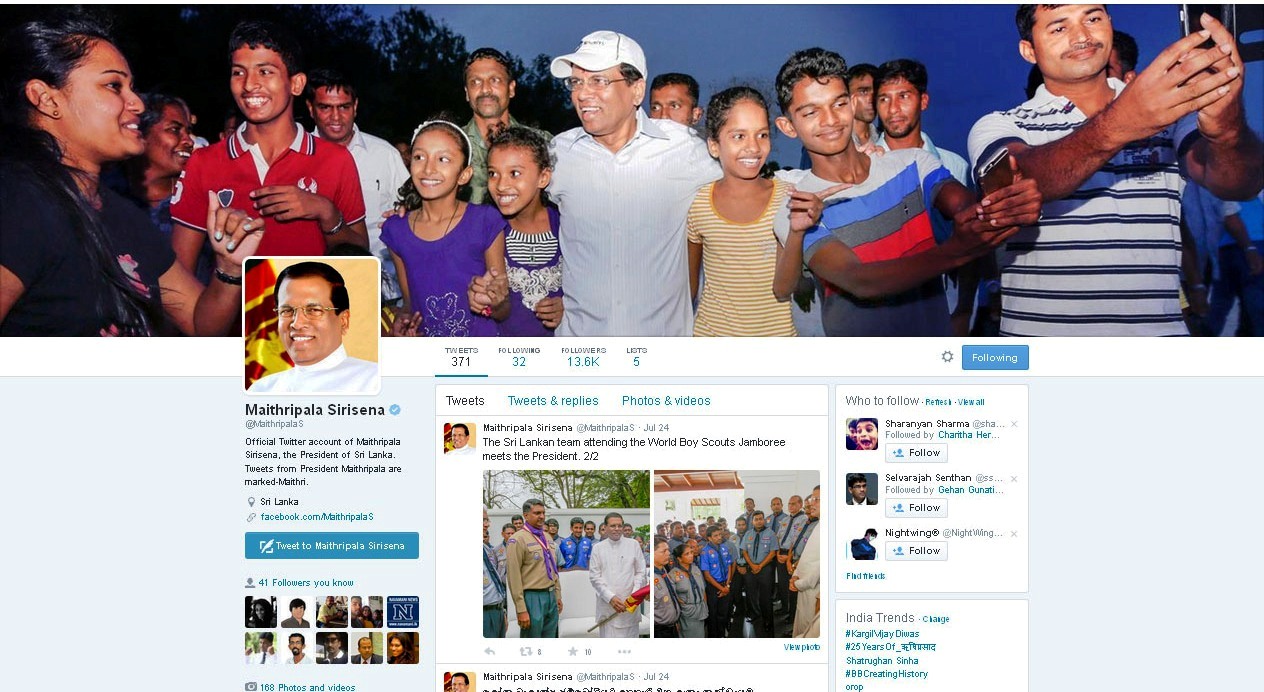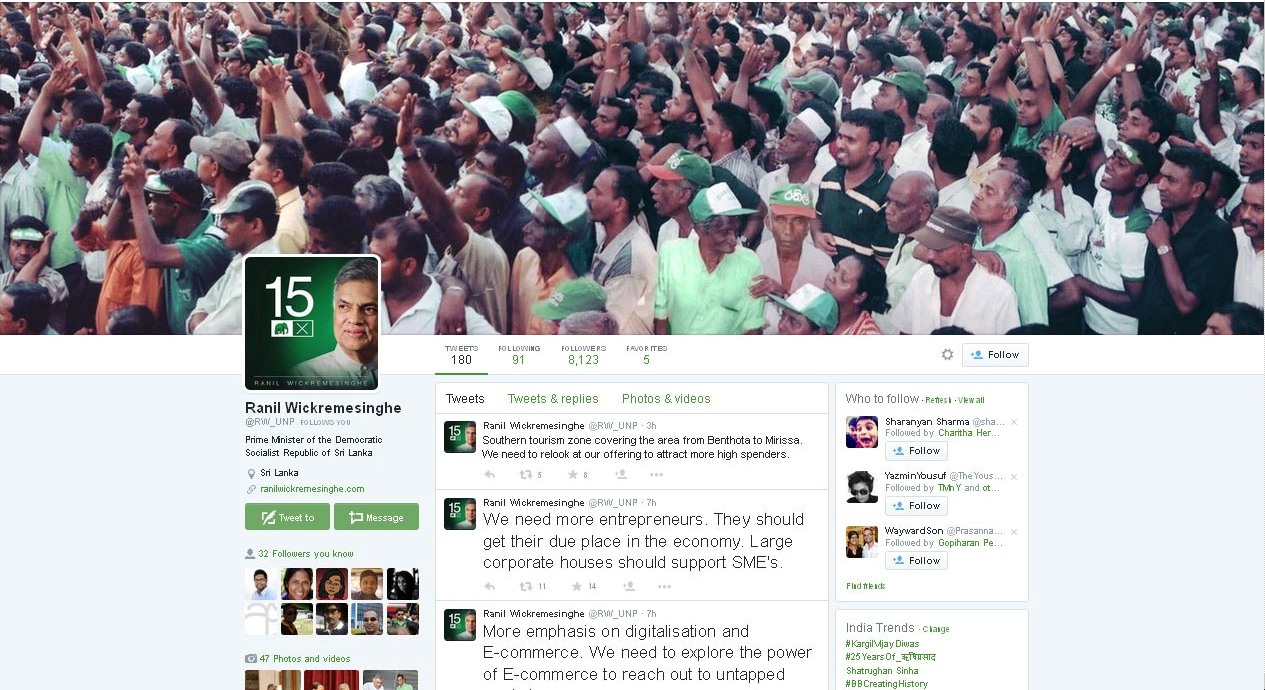What role (if any) did social media play in the recently concluded Parliamentary (General) Election on 17 August 2015?
Many are asking this question – and coming up with different answers. That is characteristic of our new reality: there is no single right answer when it comes to multi-faceted and fast-evolving phenomena like social media.
Shortly after the Presidential Election of 8 January 2015 ended, I called it Sri Lanka’s first cyber election. That was based on my insights from over 20 years of watching and chronicling the gradual spread of information and communications technologies (ICTs) in Sri Lanka and the resulting rise of an information society.
However, that was not the first time social media had figured in Lankan election campaigns. The trend started slowly some years ago, with a few tech-aware politicians and advertising agencies using websites, Facebook pages and twitter accounts for political outreach. For the most part, these remained one-way communications with little engagement that the web allows.
In any case, such sporadic uses did not reach a ‘critical mass’ in the general and presidential elections held in 2010, or in any of the provincial and local government elections held thereafter.
With Chanuka Wattegama, I studied the Colombo Municipal Council election in October 2011 and concluded: “There is no unequivocal evidence to prove that the use of social media, on their own, significantly changed CMC election results in 2011. As with all election campaigns, the influences were many, varied and nuanced.”
We optimistically added in our conclusion: “Nevertheless, social media enabled urban, tech savvy individuals – young and old — from different social and cultural backgrounds to engage in the political discourse. This is noteworthy when the overall trend among many young people is political apathy. To that extent, this election may one day be seen as a turning point in electronic citizenship engagement in Sri Lanka’s governance and politics.”
In the event, it took only three years to get there. By late 2014, not only were many more people online but also discussing politics as never before. This time around, the frontrunners were not politicians or their support teams but politically charged and digitally empowered citizens, especially youth.
As I noted in an earlier article, during weeks preceding the last Presidential election, hundreds of thousands of Lankans from all walks of life used social media to vent their frustrations, lampoon politicians, demand clarity on election manifestos, or simply share hopes for a better future. Most of them were not traditionally supporting any political party or candidate. They were just fed up with years of mega-corruption, nepotism and malgovernance. It was mostly protest votes.
These scattered and disjointed protests – both online and offline – added up to defeat strongman Mahinda Rajapaksa, who only weeks earlier had appeared invincible. His opponent Maithripala Sirisena won by just over 449,000 votes.
Contrary to some claims (especially by the loser), that peaceful regime change was entirely home-grown and not externally driven. Whereas earlier generations of Lankans readily took to the streets in political demonstrations (or worse), today’s more tech-savvy citizens seem to have opted to discuss, debate and clamour for political reforms using web-based tools and online platforms. The only ‘outsiders’ involved in these processes are the various Lankan diasporas and expat Lankans who have a legitimate connection.
So what does this newer form of political expression and exchange mean for our society and polity as a whole?
Questions that I raised earlier this year are still going in search of answers: Did inter-personal communications and myriads of open, public conversations in social media raise the level of public awareness of key political and policy issues relevant to this year’s two elections? How much of this citizen awakening can be attributed to the fast spread of smartphones and broadband internet? Or were there other factors also at work?
Even more importantly, could fleeting communications on social media really have influenced the voting choice of millions of men and women who ‘walked into those little booths, with a little pencil, making a little cross on a little bit of paper’ both on January 8 and August 17?
We honestly don’t know – yet.
We are left with more questions than answers about exactly what sociological and psychological factors are at work in the nexus between electoral processes and social media use (hence the need for more social scientists to research this topic).
Web’s long shadow
First, what about the perception that web use is limited to a ‘privileged few’ with English language skills? That used to be the case, but not any longer. After 20 years of commercial Internet connectivity, it is finally becoming a more widely used medium. By end 2014, there were some 3.3 million Internet subscriptions in Sri Lanka, says the Telecom Regulatory Commission (TRC). Most of them (82%) were mobile subscriptions.
As Internet subscriptions are often shared among family members or co-workers, the number of users is actually higher. Some estimates put it at around 5 million. The Internet Society – a global association of technical professionals – last year said that 22% of Sri Lanka’s population regularly uses the web. So almost one in four Lankans is now connected.
In fact, the web’s influence reaches a much larger section of society than those directly accessing it. This is due to ‘information multipliers’ – such as teachers, journalists and activists – with significant audiences of their own. What they access is shared widely in their ‘offline’ networks.
Thus the web casts a larger ‘shadow’ on Lankan society than appears at first glance.
And with a proliferation of Sinhala and Tamil language apps, users are communicating in native tongues and various ‘hybrids’ such as Sin-glish. Urban-rural and class divides have been lowered or blurred. Users in Vavuniya are using Google apps just as eagerly as those in, say, Matara or Colombo.
The real ‘game-changer’ in recent years has been the spread of smartphones. An estimated 3 million are being used in Sri Lanka (and rising), all capable of web browsing from anywhere with mobile signal coverage. A lower end smartphone costs around LKR 10,000 (approx USD 75) while call and data transfer costs are among the lowest in Asia.
All these factors have set off a social media explosion. Total numbers keep rising, and Facebook clearly dominates social media use in Sri Lanka: there were over 2.5 million accounts by end 2014. Among other popular platforms are Twitter (micro-blogging), Instagram (photo sharing), YouTube (video sharing) and instant messaging services such as Viber and WhatsApp.
Academic studies on social media trends in Sri Lanka are rare, but some market research and industry surveys offer useful insights. For example, a 2013 survey found that 42% of Facebook users in Sri Lanka communicate using two languages. An average user spent approximately 34 minutes per day on Facebook (with over a third of users checking their account 8 times a day). Over half (58%) of users said they access Facebook on mobile phones.
Politics online
It is against this backdrop that two key national elections took place just 222 days apart this year. From all indications, these political events inspired a great deal of discussion and content sharing in a multitude of social media platforms – most notably on Facebook and Twitter.
This is not at all surprising, as we are a very politically conscious people.
We talk politics at every available opportunity. Everyone has a political opinion and, apparently, every second person has a favourite conspiracy theory too. We have been participating in elections for over 80 years, since universal adult franchise was introduced in 1931. We used to sack governments every few years, although it has happened less frequently in recent decades.
Extending our political fervour to cyberspace has opened up new opportunities for political party campaigning as well as civil society advocacy on democracy, good governance, clean candidates and the need to abide by election laws and regulations.
Just as important, social media enables Lankans living and working overseas to connect to conversations that are shaping the political future of their homeland. Given that an estimated 1 out of every 11 Lankans is based outside the island, this does matter: even if they can’t vote (yet), they can at least have their say. This really matters.
Given the very large number of voices, conversations and acts of sharing taking place in social media day and night, no one can keep track of everything going on in social media. This is where common sorting devices and statistical analyses become helpful.
Public archiving of accessible social media content (i.e. not in closed conversations as often happens on Facebook) – as done by Groundviews.org – also preserves the raw material for future analysis by researchers (take this hint, all data crunchers!).
Many (but not all) social media interactions (especially on Twitter) during the general election campaign and immediate post-election periods used two common hashtags — #GenElecSL and #SLGE15. This enabled easy aggregating which, in turn, enhanced sharing and interactions (i.e. even those who don’t normally follow some individual accounts would get to see new content by simply following what is being posted with those hashtags).
Facebook Electioneering
During #GenElecSL campaigning period, Facebook emerged as a widely used space as never before.
For the first time, the Department of Elections itself engaged the social media. Shortly after nominations closed, it created a Facebook page named ‘Tell Commissioner’ where public was invited to share complaints and evidence related to violations of the election law.
Some citizens engaged the Commissioner via text and/or images – not only highlighting apparent violations by political parties and candidates, but sometimes also by the mainstream media. In a refreshing departure from the typical public sector entity, the Department replied these citizens online – promising to investigate, then reporting back on action taken, and sometimes clarifying that the laws or regulations had not been violated in certain instances.
During the run-up to the election, the Commissioner also used his Facebook page for voter education – for example, to remind employers of their legal obligation to provide paid leave for their staff to cast their vote, and to explain to voters how to use the ballot paper correctly to exercise their franchise.
And when some mischief-makers circulated a story on stolen ballot papers (using a 2013 image), the Commissioner used both his Facebook page and mainstream media to dismiss this as a gross fabrication.
It is not clear how the citizen engagements (by way of comments) on this FB page would be archived for reference. Some discussions – albeit fleeting – touched on matters of policy implications that should ideally be followed up when updating elections related laws and regulations.
For example, Parliament Elections Act No 1 of 1981 has no specific mention of any restrictions on the incumbent prime minister and ministers participate in national or religious events during campaigning period. This time around, the Commissioner acted under the 19th Amendment to the Constitution to formulate (legally non-binding) guidelines and ethics covering such conduct – and publicised them through the official Facebook page.
Other discussions on Facebook that have policy implications for the future include whether and how to create a mechanism where Lankans expatriates working overseas can vote in elections in Sri Lanka by means of “Absentee Voting System“, and extending campaigning related regulations to candidates’ social media activity as well.
On election day, in another first, Facebook itself reminded all users based in Sri Lanka of this event — and encouraged them to update their status messages around the election.
As cyber activist and researcher Sanjana Hattotuwa noted, “While opt-in (users could choose to ignore the Facebook prompt) this move by Facebook around voter mobilisation resulted in thousands updating their Facebook status to reflect the fact they were going to vote, had voted and various shades of political opinion.”
The FB status message also linked to the Election Department’s official website, which crashed several times during the election day and subsequent high volume periods – highlighting the need for urgent overhaul in its capacity.
Some citizen groups, meanwhile, used Facebook and other social media to encourage all registered voters (15,044,490) to turn up and cast their vote to a party or candidate of their choice. Groundviews.org and its sister websites had created a trilingual “I Will Vote” icon campaign in January, which was revived for the general election. A new group of digital activists, calling themselves as “Hashtag Generation” released several creative memes urging everyone to perform their civic duty by voting. (In the end, voter turnout was 77.66% — commendable, but less than that of the Presidential Election: 81.52%).
There were many other groups and individuals who used social media for spreading public interest messages during election time. Notable among them were the March 12 Movement for Clean Politicians (a broad alliance of many civil society groups), and the Vote for Women campaign (#VoteWomenSL) undertaken by several advocacy organisations.
As the election result showed, neither campaign was too successful. Some politicians with dubious track records received their party nominations and, having garnered enough preferential votes, entered the new Parliament. And out of a total of 556 women candidates from 21 political parties and independent groups, only 11 were successful. This indicates much unfinished business in building an inclusive and participatory governance system in Sri Lanka.
Facebook Influencers
Civil society and advocacy groups were active on Facebook promoting apolitical messages, but they were outnumbered by social media based promotion of individual candidates.
Such promotion was undertaken by candidates themselves, their campaign teams as well as well-wishers. Many more social media users also openly declared their voting preferences, political opinions and political opposition. This greater openness is probably a reflection that the fear psychosis prevailing during the pre-January 8 decade is giving way to a culture of argumentative debate, as prevails in neighbouring India.
As Hattotuwa noted in a commentary on social media use during the election, “The open publication of political preferences – not just to Facebook friends, but as public posts anyone even without a Facebook account, or outside one’s friend’s network could see – is a major development in the discursive landscape of social media, and was reflected in updates in Sinhala and Tamil too.”
In this intense cacophony, who stood out — and whose social media brands were more influential?
Immediately after the general election ended, Yudhanjaya Wijeratne — who describes himself as a ‘geek, blogger and wordslinger’ — did a quick analysis to discern key trends on Facebook and Twitter in relation to the election. In particular, he probed who were the biggest influencers during the campaigning period. So far, his is the only publicly available analysis (although several researchers and marketing companies are believed to have monitored the phenomenon).
The key to assessing social media influence — as Yudhanjaya has done — is to understand that it is not just a numbers game. A politician or activist or marketer who has a large number of followers does not necessarily influence if they have little or no engagement. To draw a rough analogy from the physical world, social media ‘likes’ are akin to fleeting crowds at political rallies, whereas engagement is more like candidates’ house visits – harder, but ultimately more useful in branding and constituency building.
As Yudhanjaya says, “Engagement here is everything – clicks; post likes; post comments; shares; video plays.”
Oh, and don’t forget that social media likes and followers can be ‘rented’ in bulk from ‘click-farms’ in some countries. This explains why certain Lankan politicians have more Facebook fans in Turkey, for example, than at home! Tens of thousands of likes or fans may give the (false) impression of popularity but it does little to enhance one’s influence on social media. And influence is what really matters, especially during elections.
Yudhanjaya made these key observations on Facebook during the August general election, viz:
- Far more than political party pages, politicians’ personal pages show the biggest presence on Facebook.
- The top two on the list — Maithripala Sirisena (726,552 likes) and Mahinda Rajapaksa (712,216 likes) — had roughly similar amounts of total likes and Sri Lankan likes (both above 75%).
- When it came to engagement (during the week prior to the election), most politicians with high numbers of ‘likes’ did not figure prominently. When arranged in descending order, the top five political accounts that engaged the most on Facebook were: Mahinda Rajapaksa (473,952 accounts engaged), Ranjan Ramanayake (405,169), Anura Kumara Dissanayake (239,490), UPFA – A Brighter Future (188,703) and Ranil Wickremesinghe (153,497).
“It’s startling to see that One Shot (a screen name for actor-turned-politician Ramanayake), pre-election, was garnering a lot more attention than President Maithripala Sirisena: he’s clearly playing a much better social media game,” notes Yudhanjaya.
President Sirisena, whose likes are on par with Rajapaksa, was nowhere near the top when it came to engagement. Yudhanjaya speculates that since the President wasn’t contesting in this election, “he chose to stay away and not stir the fires”. [Full analysis here.]
My own cumulative observation from the past several months is that In President Sirisena and Prime Minister Wickremesinghe are using their Facebook and Twitter accounts only or mostly to ‘broadcast’ some news and images, but hardly to engage citizens. Neither has granted a live online Q&A session on Twitter or Facebook (cyber equivalent of a press conference) despite some of us repeatedly asking for one. Evidently, their social media advisors or teams do not appreciate the value of such engagement (as opposed to mere presence or ‘likes’).
In contrast, Mahinda Rajapaksa has been going live Q&As both while in office and also after his January defeat. Of course, he (or his SM team) carefully chooses which questions are answered, sidestepping more contentious ones. That’s their prerogative. At least they engage.
Whatever we may think of his politics and track record, Mahinda Rajapaksa’s online persona (carefully managed by his team) is neither aloof nor inaccessible. Some of his associates — such as Dr Charitha Herath [@charith9] and Anuradha Herath [@AnuradhaKHerath] — are also active in social media under their own names, using verified (identity confirmed) accounts. Other Lankan politicians can learn much from their strategies and tactics.
Tweet, Tweet!
If Facebook is the overcrowded ‘bazaar’ on social media street, Twitter is the place where many news junkies and opinion-shapers hang out (I once called it the ‘deeper end of the social media pool’, but that view was contested).
One thing for sure, though: ground rules at the Tweetie bird’s tent (maximum 140 characters including spaces) promote brevity and focus.
Sri Lanka’s regular Twitter user base is still small, probably under 50,000. But a growing number of political, business and academic leaders have joined – if only to use it as a listening post.
Over eight weeks in July – August 2015, Groundviews archived all tweets tagged with either #SLGE15 or #GenElecSL. Once a week throughout that period, these archives were released over Twitter for anyone to browse through or download.
As Groundviews editor Sanjana Hattotuwa noted, “Sentiments, positions, promises and statements expressed over Twitter, an ephemeral medium, become extremely difficult to index and search for as time goes by. Content on Twitter, including linked images, web content and audio are an important historical record of elections in helping provide context. From candidates to voters, from those in Sri Lanka to commentators in the diaspora and beyond, from the official accounts of leading political parties to the President of Sri Lanka, these eight weeks saw well over 174,633 tweets generated over both hashtags (126,099 of which were #GenElecSL), making it even in comparison to January’s Presidential Election the most tweeted election in our history.”
On the Morning After (18 August 2015), as the official results were coming in, Sanjana noticed how both hashtags generated unprecedented volumes of social media traffic. #SLGE15 at around 7.30am was peaking at around 9 tweets a minute, and #GenElecSL at around 24 tweets a minute.
Says Sanjana: “As long as Groundviews has archived public tweets around events in Sri Lanka (Twitter Q&A, UN debates, elections) this was the most amount of tweets ever published in the same span of time.”
My guess is that most of the over 300,000 tweets with either #GenElecSL or #SLGE15 were generated not by election candidates or their campaigners or political parties, but by others – principally by a few cyber-savvy mainstream media journalists and hordes of citizen journalists or politically charged activists.
The two politicians who consistently showed up on both Twitter and Facebook analyses by Yudhanjaya Wijeratne are: Maithripala Sirisena and Mahinda Rajapaksa.
As Yudhanjaya explains, “This is to be expected – in a sense, this election is still a continuation of debate between the ethos and values espoused by these two political behemoths. We saw many others rise to the social media game – what was basically a case of Maithripala + Ranil vs The Rajapaksa Clan and Assorted UPFA pages dissolved into a horde of individual politicians screaming for attention – but nevertheless, a sizeable fraction of the biggest influencers this time around were also the same people from the January 8th election. After all, audiences and reputations carry over, and people are listened to.”
Yudhanjaya’s analysis found, among other things, that many election related Twitter conversations were taking place among a relatively small number of users (6,184 conversations among 1,774 people), and journalists and media-affiliated accounts, seem to wield substantial influence in this sphere.
In his top 10 Twitter influencers during #GenElecSL, there are five such accounts (@nalakag; @Groundviews; @dinouk_c; @azzamameen; and @dmbreakingnews). The others are: @upfasl; @srilankatweet; @rw_unp; @maithripalas; and @presrajapaksa
I have to agree with Yudhanjaya that Twitter in the Lankan context is “mostly a handful of influencers convincing each other”.
He adds: “While the real-life impact cannot be quantified, I have a feeling that this space – already demographically skewed towards more ‘connected’ people than your average Facebook use – may not really be worth engaging in for many politicians.”
Arise, Netizens of Lanka!
A smart politician (may their tribe increase!) would have a presence in each key social media platform – not only during election times, but for regular engagement with constituents and other citizens.
In my weekly column for Ravaya newspaper earlier this year, I have been raising questions like these: Can political parties afford to not engage 25% of Lankan population now regularly using the web? When would election campaigners – rooted in the legacy media’s practice of controlling and fine-tuning messages – come to terms with the unpredictable and sometimes unruly nature of social media?
While politicians, their parties and paid advertising agencies struggle to find their niches on social media, we as politically conscious citizens need to up our game too.
Cyber literacy has been slower to spread than mere internet connectivity in Sri Lanka (official surveys of computer literacy do not include mobile based Internet use, and thus miss out a large part of the picture). Many social media users still cannot discern between facts, fiction and utter fabrication (as evidenced, for example, by the brilliant satirical stories by Newscurry being taken literally by some).
Worse, social media’s easy of sharing has led to rapid spread of malicious rumours discrediting individuals and entities. Among the most persistent such claims during the recent election period has been the militarily defeated Tamil Tigers (LTTE) showing signs of revival, and victory by UNP could expedite that process. Taking advantage of the web’s facility of anonymity and pseudonymity, some slandered political leaders and parties maliciously.
These excesses underline the need for greater cyber civility and user discretion, but are by no means a reason for any state regulation of social media. Even the web’s anonymity and pseudonymity are, at best, only double-edged tools: during repressive regimes (such as Sri Lanka’s Decade of Darkness, 2005-2014), these very facilities shielded dissenters from dire consequences when criticizing the ruling oligarchy.
Post January 8, however, the sheer emergence of more voices online has made rumour-mongering and hate-spreading harder. As Hattotuwa noted just after the general election, “With hundreds of independent voices all publishing at the same time and calling to question the record of the former President and those in his government, attempts to incite hatred and the use of incendiary language did not have the same impact as intended, and would have been possible under a repressive political context.”
We cannot entirely rely on the wisdom of the crowd to counter social media manipulation by various political or fanatical groups. Ideally, we should make the whole crowd wiser.
As more politicians and marketers crowd social media spaces, the need for enlightened and innovative use of social media in the public interest is greater than ever. This cannot be left to a handful of tech-savvy civil society activists (may their tribe increase, too!) or to citizen journalists.
A promising start is Manthri.lk, a trilingual website that tracks the performance of the 225 Members of Parliament in Sri Lanka. It goes by the official record (Hansard), analysing and coding each statement which is fed into a customised system. With 202 MPs seeking re-election, Manthri.lk produced ‘digital report cards’ summarising each MP’s performance. These infographics-driven data analyses were widely shared on social media, fuelling discussion on holding MPs accountable.
Yet, despite many passionate debates among netizens, some poorly-performing MPs managed to return. Evidently, our lofty online conversations need to be extended to segments of population – both urban and rural – whose voting patterns are set by different considerations.
Every citizen – including activists and academics — can play a part in shaping the future of our democracy. In this, technology is not the only key driver; what matters even more is the strategic use of our imagination and determination.
We may not yet have all the detailed answers of our digital future, but one thing is clear. In 2015, we the people of Sri Lanka embarked on a progressive digitalization of our politics and governance.
It is going to be a bumpy road – be forewarned — but there is no turning back.
Science writer Nalaka Gunawardene has chronicled and analysed the rise of new media in Sri Lanka since the early 1990s. He has also been an apolitical citizen activist online during key Lankan elections since 2011. He tweets as @NalakaG and blogs at http://nalakagunawardene.com. A compact version of this essay has appeared in the mainstream media.

